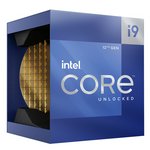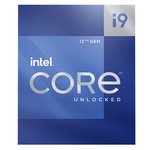Intel Core i9-12900K Alder Lake
CPUProduct Gallery


Product Overview
Intel Core i9-12900K is a flagship 10nm desktop microprocessor based on the Alder Lake architecture. It uses a new-to-x86 "hybrid" architecture with 8 performance cores and 8 efficiency cores in a 16-core, 24-thread setup. At its launch, it has the most extensive support for modern hardware and peripherals in the PC market.
Most notably, the new Alder Lake CPUs support DDR5 and PCIe 5. Thunderbolt 4 is also supported. There is still only 20 PCIe lanes, and those who wish for support for more expansion cards (such as in machine learning applications) have to look for workstation-grade processors instead.
With the efficiency cores taken out, the i9-12900K is suspiciously similar to the i9-11900K otherwise. Still, we cannot discount the added computing power as well as the possibilities to run more efficiently with this hybrid design.
The i9-12900K comes with an integrated UHD 770 GPU with some basic, though hardly exciting, graphics capabilities. Those who do not need it can opt for the i9-12900KF instead. As usual, the "K" designation means that this CPU is unlocked, though in recent years overclocking the CPU is less of a sport than it was two decades ago.
Intel now refers the 10nm process as Intel 7, ostensibly in an attempt to close the "nanometer" gap.
Ratings
What we found
Neofiliac score 82%
Pros
- 16 cores / 24 threads
- Supports DDR5 memory
- ECC memory
- Has integrated graphics
- PCIe 5.0 support
Cons
What external reviewers found
External score 75%
Pros
- Good value for money
- Excellent performance at 1080p and 4K
- Great performance for single-threaded workloads
- Strong overclocking performance
- High-quality case
- Competitive performance
Cons
- Lacks AVX-512 support
- Expensive compared to the competition
- Lackluster performance on Alder Lake platform
- Power consumption could be better
- No overclocking
Your rating:
12345678910
?/10
Price Comparison
As associates of the merchants above, we earn a commission when you make a purchase using the supplied links.
Specifications
[{"Ft":"Connectivity","Fn":"CPU Socket","Fv":"FCLGA1700"},{"Ft":"Connectivity","Fn":"PCI Express","Fv":"5.0 and 4.0, 20 lanes (Up to 1x16+4, 2x8+4)"},{"Ft":"Connectivity","Fn":"Ports","Fv":"eDP 1.4b, DP 1.4a, HDMI 2.1"},{"Ft":"Construction","Fn":"Form Factor","Fv":"Desktop microprocessor Box"},{"Ft":"Construction","Fn":"Lithography","Fv":"Intel 7"},{"Ft":"Construction","Fn":"Platform","Fv":"Alder Lake"},{"Ft":"Dimensions","Fn":"Size | Depth","Fv":"37.5 mm"},{"Ft":"Dimensions","Fn":"Size | Width","Fv":"45.0 mm"},{"Ft":"Function","Fn":"Graphics","Fv":"Intel® UHD Graphics 770, 32 execution units, Base 300 MHz, Boost 1.55 GHz, Max 4 displays, DirectX 12, OpenGL 4.5, OpenCL 3.0"},{"Ft":"Function","Fn":"Operating Temperature","Fv":"Max Tjunction 100°C"},{"Ft":"Function","Fn":"Processor | Cores","Fv":"16 Cores (8 performance cores / 8 efficient cores)"},{"Ft":"Function","Fn":"Processor | Threads","Fv":"24 Threads"},{"Ft":"Function","Fn":"Resolution","Fv":"Max res DP 7680 x 4320 @ 60Hz / Max res HDMI 4096 x 2160 @ 60Hz"},{"Ft":"Function","Fn":"Security","Fv":"vPro Enterprise, Threat Detection Technology (TDT), Active Management Technology (AMT), Standard Manageability (ISM), One-Click Recovery, Hardware Shield Eligibility, Control-Flow Enforcement Technology, Total Memory Encryption - Multi Key, Total Memor..."},{"Ft":"Function","Fn":"Supported Technologies","Fv":"Gaussian \u0026amp;amp; Neural Accelerator 3.0, Thread Director, Deep Learning Boost (Intel DL Boost), Optane™ Memory Supported, Speed Shift Technology, Turbo Boost Max Technology 3.0, Hyper-Threading Technology, Enhanced Intel SpeedStep Technology, Thermal..."},{"Ft":"Function","Fn":"Thermal Solution","Fv":"PCG 2020A"},{"Ft":"Function","Fn":"Video","Fv":"Clear Video HD Technology"},{"Ft":"Performance","Fn":"Cache","Fv":"30 MB Intel® Smart Cache14 MB L2"},{"Ft":"Performance","Fn":"Frequency","Fv":"Max Turbo: 5.20 GHz(Max P-core: 5.10 GHz / Max E-core: 3.90 GHz) | (Base P-core: 3.20 GHz / Base E-core: 3.20 GHz)"},{"Ft":"Performance","Fn":"Memory | Capacity","Fv":"Supports up to 128 GB"},{"Ft":"Performance","Fn":"Memory | Type","Fv":"Up to DDR5 4800 MT/s, Up to DDR4 3200 MT/s, Max 2 channels, ECC supported, Max bandwidth 76.8 GB/s"},{"Ft":"Performance","Fn":"Power Consumption","Fv":"125 W Base / 241 W Turbo"},{"Ft":"Production","Fn":"Debut","Fv":"2021 Q4"},{"Ft":"Production","Fn":"Model Name","Fv":"i9-12900K"}]
External Reviews
anandtech[1]
Reviewer score 76% (normalized by Neofiliac)The new memory standard offers a substantial uplift when it comes to memory bandwidth. DDR5 had a minor lead in single threaded tests but in a lot of multithreaded tests, the lead was significant. The Golden Cove core inside Alder Lake has reclaimed the single-threaded performance crown with an uplift in SPEC of 18-20%.
Pros
- Great performance for single-threaded workloads
- Dedicated E-cores
- Good value for money
Cons
- Expensive compared to the competition
- Lacks AVX-512 support
digitaltrends[2]
Reviewer score 73% (normalized by Neofiliac)The Core i9-12900K boasts a single-core boost of 5.2GHz, which I hit time and again during testing. In a 30-minute AIDA64 stress test, the chip managed an all-core frequency of 4.8GHz, reaching a peak of 84 degrees Celsius while drawing 210W of power. The chip represents a lot of things for Intel, but more than anything, it represents a company that’s ready to get competitive again.
Pros
- Competitive performance
- High power demands
- Strong overclocking performance
Cons
- Power consumption could be better
pcmag[3]
Reviewer score 70% (normalized by Neofiliac)The Intel Core i9-12900K is an impressive first showing for its desktop processors built off the new 7 Process. For content creators, the cost proposition of 12th Gen perks up, thanks to several outright wins. But on cost of adoption, the percentages are still skewed in AMD's favor.
Pros
- Competitive price-per-core for a desktop processor built off Ryzen 9 5950X
- Competitively priced
Cons
- Lackluster performance on Alder Lake platform
trustedreviews[4]
Reviewer score 81% (normalized by Neofiliac)The Intel Core i9-12900K was the most powerful processor in the group test, but only saw marginal gains over its 11th Gen predecessors. It’s certainly a power hog, consuming more power than any of the other processors on test – but it didn’t consume quite as much power as you might expect. You’ll still need a fairly high-spec power supply if you’re going to pair this chip with a high-end power supply. The added outlay of a cooler also pushes up the cost of the chip.
Pros
- Extremely powerful
- Excellent performance at 1080p and 4K
- High-quality case
Cons
- No overclocking
References
<
>
x